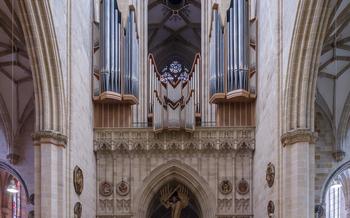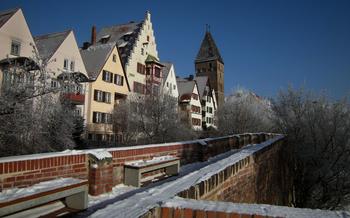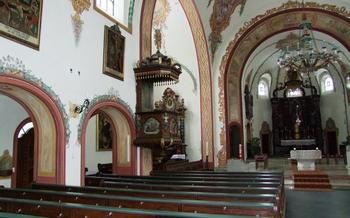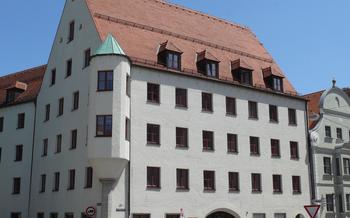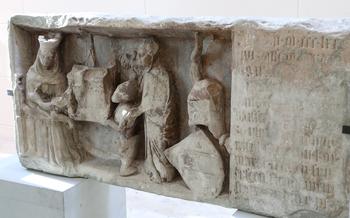
Ulm Minster (Ulmer Münster)
- The Ulm Minster: An Architectural Masterpiece
- Exploring the Interior
- Ascent to the Observation Deck
- The Astronomical Clock
- A Masterpiece of Mechanical Ingenuity
- A Celestial Spectacle
- A Showcase of Astronomical Knowledge
- A Fusion of Art and Science
- Guided Tours and Audio Guides
- Visiting the Treasury
- Events and Concerts
- The Legend of the Sparrow
- The Minster Square
- The Danube River and Boat Tours:
- The Ulm Museum
- The Town Hall and Marktplatz:
- The Blaubeuren Abbey
- The Wiblingen Abbey
- Insider Tip:
The Ulm Minster: An Architectural Masterpiece
In the heart of Ulm, Germany, stands the majestic Ulm Minster, a testament to human ingenuity and devotion. This colossal Gothic masterpiece, soaring over the city's skyline, has captivated visitors for centuries with its intricate details and architectural prowess. Its construction, spanning over 500 years, involved renowned architects such as Ulrich Ensingen and Matthäus Böblinger, who left their indelible mark on this magnificent edifice. Recognized as a UNESCO World Heritage Site, the Ulm Minster stands as a symbol of Germany's rich cultural heritage and architectural achievements.
Exploring the Interior
The interior of the Ulm Minster is an awe-inspiring testament to the skill and artistry of its builders. The vast nave, with its soaring pillars and intricate ribbed vaulting, creates a sense of grandeur and spirituality. The stained glass windows, depicting scenes from the Bible, cast a colorful glow on the interior, while the intricate carvings and sculptures adorning the walls, columns, and choir stalls add to the rich visual experience.
One of the highlights of the interior is the choir, with its exquisitely carved choir stalls. Each stall is adorned with unique carvings depicting biblical figures, saints, and scenes from everyday life. The intricate details and craftsmanship of these stalls are simply breathtaking, showcasing the incredible skill of the medieval artisans who created them.
Ascent to the Observation Deck
The climb to the observation deck of the Ulm Minster is a challenging but rewarding experience. The 768 steps wind their way up through the tower, providing glimpses of the intricate architecture and stunning stained-glass windows along the way. The effort is well worth it, as the panoramic views from the top are simply breathtaking.
On a clear day, visitors can see for miles in every direction. The city of Ulm lies spread out below, with its red-tiled roofs and narrow streets. The Swabian Alps rise up in the distance, their peaks capped with snow. And to the south, the mighty Danube River winds its way through the landscape.
The observation deck offers a unique perspective on the minster itself. Visitors can see the intricate details of the spire up close, and they can appreciate the sheer size and scale of the building. It is a truly awe-inspiring sight that will stay with visitors long after they have left Ulm.
Here are some practical tips for making the most of your ascent to the observation deck:
- Wear comfortable shoes, as the climb can be strenuous.
- Take your time and rest as needed. There are several landings along the way where you can stop to catch your breath and enjoy the views.
- Be aware that the tower can be narrow and crowded, especially during peak tourist season.
- If you are afraid of heights, you may want to consider taking the elevator to the observation deck. However, the elevator only goes up to the first landing, so you will still need to climb the remaining stairs to reach the top.
The Astronomical Clock
A Masterpiece of Mechanical Ingenuity
Within the awe-inspiring interior of the Ulm Minster lies a captivating masterpiece of mechanical ingenuity – the renowned Astronomical Clock. Constructed in the 16th century, this intricate timepiece stands as a testament to the skill and artistry of its creators. The clock's elaborate mechanism, comprising over 30,000 individual parts, captivates visitors with its intricate workings and fascinating display.
A Celestial Spectacle
Every hour, the Astronomical Clock comes to life, presenting a mesmerizing celestial performance. As the hour strikes, a procession of moving figures emerges from the clock's interior, representing the different stages of life: childhood, youth, adulthood, and old age. These figures, accompanied by the sound of chimes, symbolize the passage of time and the cyclical nature of life.
A Showcase of Astronomical Knowledge
The clock's most remarkable feature is its celestial display, showcasing the positions of the planets and the phases of the moon. This intricate mechanism, driven by a complex system of gears and weights, accurately depicts the movements of the heavenly bodies, offering visitors a glimpse into the wonders of the cosmos.
A Fusion of Art and Science
The Astronomical Clock of Ulm Minster stands as a remarkable fusion of art and science. Its intricate mechanics, combined with its artistic design and symbolic representations, create a captivating spectacle that has fascinated visitors for centuries. This masterpiece of horology serves as a reminder of the ingenuity and creativity that can arise from the intersection of art and scientific knowledge.
Guided Tours and Audio Guides
Guided Tours:
Dive into the fascinating history, architecture, and artwork of the Ulm Minster by joining a guided tour. These tours are available in various languages, ensuring accessibility for visitors from different backgrounds. Led by knowledgeable and passionate guides, you'll gain insights into the construction, design, and symbolism of the minster, unraveling its many stories and legends. From the grand nave to the intricate choir stalls, each element of the minster will come alive as you explore its depths.
Audio Guides:
For a more personalized and self-paced experience, opt for an audio guide. These guides offer a comprehensive commentary on the minster's highlights, allowing you to explore at your own pace while learning about the building's rich heritage. With audio guides available in multiple languages, you can immerse yourself in the minster's captivating narrative without language barriers.
Insider Tips:
- To ensure the best experience, book your guided tour or audio guide in advance, especially during peak tourist season.
- For a more in-depth understanding, consider joining a specialized tour focusing on specific aspects of the minster, such as its architecture, artwork, or history.
- If you prefer a more intimate experience, opt for a small group tour or a private tour with a dedicated guide.
Visiting the Treasury
The Ulm Minster's treasury is a treasure trove of precious artifacts and religious treasures that have been carefully preserved and showcased for visitors to admire. Among the notable pieces in the collection is the stunning silver altar, a testament to the craftsmanship of the medieval period. Its intricate carvings depict scenes from the life of Christ and the saints, capturing the essence of religious devotion and artistry.
Another highlight of the treasury is the collection of medieval manuscripts, which offer a glimpse into the intellectual and spiritual life of the past. These beautifully illuminated manuscripts contain texts ranging from religious scriptures to historical chronicles, providing valuable insights into the beliefs and practices of the time.
Each item in the treasury has its own unique story to tell, shedding light on the history and significance of the Ulm Minster. The treasury serves as a reminder of the enduring power of faith and the dedication of those who have contributed to the preservation of these precious artifacts. Visitors are encouraged to take their time exploring the treasury, allowing themselves to be transported back in time as they marvel at the exquisite craftsmanship and historical significance of the displayed items.
Events and Concerts
The Ulm Minster is not only a magnificent architectural marvel but also a vibrant cultural hub. Throughout the year, the minster plays host to a variety of events and concerts that cater to diverse tastes and interests. Classical music enthusiasts can indulge in the enchanting sounds of organ recitals, while choral concerts fill the air with harmonious melodies. The minster's exceptional acoustics enhance these performances, creating an immersive and unforgettable experience for music lovers.
Regular events such as guided tours and thematic exhibitions provide visitors with deeper insights into the minster's history, architecture, and artwork. These events offer a unique opportunity to learn about the significance of the minster and its role in the cultural landscape of Ulm.
To make the most of your visit, check the event schedule in advance to plan your trip accordingly. Advance booking for concerts and special events is recommended to avoid disappointment. Whether you're a music aficionado or simply seeking a unique cultural experience, the Ulm Minster's events and concerts are sure to leave a lasting impression.
The Legend of the Sparrow
Among the many tales associated with the Ulm Minster, the legend of the sparrow holds a special place in the hearts of locals and visitors alike. It is said that during the construction of the minster's towering spire, the builders encountered a seemingly insurmountable challenge. The spire was nearing completion, but a small gap remained at the very top, and no matter how hard they tried, they could not find a way to fill it.
One day, as the builders were contemplating their dilemma, a small sparrow flew by carrying a twig in its beak. The sparrow dropped the twig into the gap, and to their astonishment, it fit perfectly. Inspired by this seemingly insignificant act, the builders were able to complete the spire, and the minster stood tall and proud, a testament to the power of perseverance and the unexpected help that can come from the smallest of creatures.
The legend of the sparrow is not just a charming story; it also holds symbolic meaning. The sparrow represents humility and the idea that even the smallest contribution can make a big difference. It is a reminder that we should never underestimate the power of our actions, no matter how small they may seem.
The legend is depicted in a beautiful stained glass window inside the minster, a testament to its enduring significance. The window shows the sparrow carrying the twig, with the unfinished spire in the background. It is a reminder that even in the face of seemingly insurmountable challenges, hope and perseverance can prevail.
The Minster Square
The vibrant Minster Square, known as Münsterplatz, is the heart of Ulm, pulsating with energy and historic charm. Surrounding the majestic Ulm Minster, this cobblestone square is a captivating blend of architectural wonders, lively cafes, and bustling markets. Stroll through the square and admire the Gothic facades of historic buildings, each with its own unique story to tell.
Indulge in the local culinary delights at one of the many cafes and restaurants lining the square. From traditional German cuisine to international flavors, there's something to satisfy every palate. Don't miss the weekly farmers' market, where local vendors showcase their fresh produce, artisanal cheeses, and handmade crafts. Immerse yourself in the lively atmosphere as you mingle with locals and fellow travelers, soaking up the essence of this vibrant city.
The Danube River and Boat Tours:
The mighty Danube River flows gracefully past the city of Ulm, offering a serene and picturesque backdrop to the towering Ulm Minster. This majestic river, one of Europe's longest, adds to the charm of the city, inviting visitors to embark on a delightful journey through its scenic landscapes.
Boat tours departing from Ulm provide an exceptional opportunity to admire the city's skyline, dominated by the majestic minster, from a unique perspective. As the boat glides along the tranquil waters, passengers are treated to breathtaking views of the minster's intricate Gothic architecture, its towering spire reaching towards the heavens. The surrounding countryside, with its rolling hills, lush meadows, and charming villages, further enhances the visual spectacle.
These boat tours offer a relaxing and informative experience, allowing visitors to learn about the history and significance of Ulm and its surroundings. Knowledgeable guides narrate the stories of the city's past, pointing out landmarks and sharing insights into the region's rich cultural heritage.
Whether you choose a leisurely sightseeing cruise or a more adventurous journey exploring the river's hidden gems, a boat tour on the Danube is a memorable experience that should not be missed. Embrace the tranquility of the river, marvel at the beauty of the landscapes, and create lasting memories against the backdrop of the awe-inspiring Ulm Minster.
The Ulm Museum
Just a short walk from the majestic Ulm Minster, the Ulm Museum invites you on a journey through time, shedding light on the rich history, culture, and artistic heritage of Ulm and the surrounding region. This treasure trove of knowledge houses an impressive collection spanning from prehistoric artifacts to contemporary artworks, offering a comprehensive insight into the city's evolution.
History and Culture Woven Together:
As you step into the museum's grand halls, you'll be greeted by a captivating narrative that unfolds through interactive exhibits, thought-provoking displays, and carefully curated artifacts. Delve into the depths of Ulm's medieval past, where you'll discover the city's role as a thriving trade center and witness the grandeur of its imperial heritage. Explore the impact of the industrial revolution, which transformed Ulm into a hub of innovation and progress. And don't miss the contemporary art section, where local and international artists showcase their bold and visionary creations.
A Tapestry of Art and Artifacts:
The Ulm Museum's collection is as diverse as it is compelling. Marvel at the intricate details of prehistoric tools and weapons, remnants of a time when humans first settled in this region. Admire the exquisite craftsmanship of medieval sculptures, paintings, and tapestries that adorn the museum's walls. Trace the evolution of art through the centuries, from the Renaissance to the Baroque period, and encounter works by renowned masters that capture the essence of their time.
Connections to the Ulm Minster:
Throughout the museum's exhibits, you'll find intriguing connections to the Ulm Minster, revealing the intertwined history of these two iconic landmarks. Discover the role that the minster's architects and artisans played in shaping the city's artistic landscape. Learn about the cultural events and religious ceremonies that took place within the minster's hallowed halls, leaving an indelible mark on Ulm's cultural identity.
Exploring the Museum:
To fully appreciate the richness of the Ulm Museum, set aside a few hours to wander through its galleries and engage with the interactive displays. Guided tours are available in various languages, providing insightful commentary and anecdotes that bring the exhibits to life. Or, opt for a self-guided tour using the museum's audio guide and immerse yourself in the stories behind the artifacts at your own pace.
Combining History and Art:
For a truly immersive experience, combine your visit to the Ulm Minster with a visit to the Ulm Museum. These two cultural gems, standing side by side, offer a comprehensive exploration of Ulm's rich heritage and artistic legacy. Step back in time, marvel at the architectural wonders, and uncover the stories that have shaped this vibrant city.
The Town Hall and Marktplatz:
In the heart of Ulm, a short stroll from the majestic Ulm Minster, stands the historic Town Hall, a testament to the city's rich past. This architectural masterpiece, dating back to the 14th century, captivates visitors with its intricate Gothic facade, adorned with delicate carvings and sculptures. The intricate details of the town hall's exterior hint at the treasures that await within.
Adjacent to the Town Hall lies the bustling Marktplatz, a vibrant square that throbs with life. Surrounded by colorful buildings, market stalls, and the gentle murmur of locals and tourists, the Marktplatz exudes an infectious energy. The square's cobblestone streets invite you to wander, discover hidden gems, and soak in the unique atmosphere.
Don't miss the astronomical clock on the Town Hall, a marvel of medieval engineering. Every hour, the clock comes alive with a captivating display of moving figures representing the different stages of life. The interplay of celestial bodies and intricate mechanisms adds a touch of magic to the square.
Whether you seek to delve into Ulm's history, admire architectural masterpieces, or simply soak in the lively ambiance, the Town Hall and Marktplatz are must-visit destinations.
The Blaubeuren Abbey
Just a short drive from Ulm, nestled in the picturesque Swabian Alb, lies the historic Blaubeuren Abbey. Founded in the 11th century, this former Benedictine monastery boasts a rich history and architectural splendor. Step into the abbey's serene courtyard and admire its Romanesque and Gothic influences, harmoniously blending together to create a captivating visual feast.
Once a center of learning and spirituality, the Blaubeuren Abbey played a significant role in the intellectual and cultural development of the region. Its scriptorium produced illuminated manuscripts that were renowned for their exquisite artistry and craftsmanship. Today, visitors can delve into the abbey's past through its museum, which houses a collection of artifacts, manuscripts, and artwork that provide a glimpse into the monastery's vibrant history.
The abbey church, with its soaring vaults and intricate carvings, is a testament to the skill and devotion of medieval artisans. Marvel at the stunning stained glass windows that bathe the interior in a kaleidoscope of colors, casting an ethereal glow upon the sacred space. Don't miss the opportunity to climb the abbey tower for breathtaking panoramic views of the surrounding countryside, including the distant spires of the Ulm Minster.
As you wander through the abbey grounds, take a moment to appreciate the tranquil beauty of the Blaubeuren Blautopf, a crystal-clear spring that gushes forth from the foot of a sheer rock face. This natural wonder, with its vibrant turquoise waters, is a popular spot for swimming and relaxation, offering a refreshing respite from your exploration of the abbey's rich heritage.
The Wiblingen Abbey
The Wiblingen Abbey, located just a short distance from Ulm, is another architectural gem with a rich history. Founded in the 11th century, the abbey was a Benedictine monastery and a renowned center of learning. Its impressive architecture, featuring a harmonious blend of Romanesque and Gothic styles, is a testament to the skill and artistry of the builders.
The abbey church, with its intricate carvings and stunning stained glass windows, is a sight to behold. The interior is adorned with frescoes and paintings that depict scenes from the Bible and the lives of the saints. Visitors can also explore the abbey's cloisters, which offer a glimpse into the daily lives of the monks who once resided here.
The Wiblingen Abbey is not just a historical monument; it also serves as a cultural center, hosting various events and exhibitions throughout the year. Visitors can attend concerts, workshops, and lectures that delve into the abbey's history, art, and architecture. The abbey also boasts a well-stocked library, which houses a collection of rare books and manuscripts.
To make the most of your visit, consider joining a guided tour. Knowledgeable guides will provide insights into the abbey's history, architecture, and cultural significance. You'll learn about the monks' daily lives, their contributions to scholarship, and the abbey's role in the development of the region.
Whether you're a history buff, an architecture enthusiast, or simply looking for a peaceful retreat, the Wiblingen Abbey is a must-visit destination. Its serene atmosphere, stunning architecture, and rich history will leave you feeling inspired and fulfilled.
Insider Tip:
Discover the Ulm Minster's Hidden Gems:
Early Bird Serenity: Aim to arrive at the minster early in the morning to witness its grandeur in tranquility before the crowds arrive. Savor the peaceful atmosphere and capture stunning photographs without the hustle and bustle.
Secret Stairwells: Explore the minster's hidden stairwells and passageways, leading to secluded viewpoints and nooks. Climb the winding spiral staircase to the Triforium Gallery for a unique perspective of the nave and intricate carvings.
Culinary Delights: Indulge in local culinary delights at one of Ulm's charming cafes or restaurants. Try the traditional "Maultaschen," a Swabian ravioli dish, or savor the freshly baked bread and pastries from local bakeries.
Beyond the Minster: Venture off the beaten path and discover Ulm's hidden gems. Stroll along the picturesque Fishermen's Quarter, admire the street art in the creative district, or take a leisurely walk along the banks of the Danube River.
Festivals and Events: Plan your visit to coincide with one of Ulm's many festivals and events. Experience the vibrant atmosphere of the Ulm Volksfest, immerse yourself in the medieval charm of the "Ulmer Zelt," or enjoy the lively Christmas markets during the festive season.
